
Steampunk is a subgenre of science fiction that incorporates retrofuturistic technology and aesthetics inspired by, but not limited to, 19th-century industrial steam-powered machinery. Steampunk works are often set in an alternative history of the Victorian era or the American "Wild West", where steam power remains in mainstream use, or in a fantasy world that similarly employs steam power.

Gothic fashion is a clothing style marked by dark, mysterious, antiquated, homogeneous, and often genderless features. It is worn by members of the goth subculture. Typical gothic fashion includes dyed black hair, exotic hairstyles, dark lipstick and dark clothing. Both male and female goths can wear dark eyeliner, dark nail polish and lipstick for a dramatic effect. Male goths use cosmetics at a higher rate than other men. Styles are often borrowed from the punk fashion and can also draw influence from Victorians and Elizabethan fashion. Goth fashion is sometimes confused with heavy metal fashion and emo fashion.
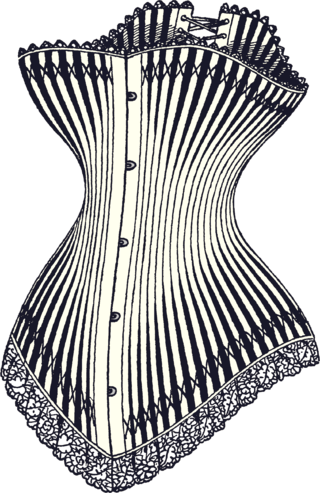
A corset is a support undergarment worn to hold and train the torso into the desired shape and posture. They are traditionally constructed out of fabric with boning made of whalebone or steel, a stiff panel in the front called a busk which holds the torso rigidly upright, and some form of lacing which allows the garment to be tightened. Corsets were an essential undergarment in European women's fashion from the 17th century to the early 20th century. In the 17th and 18th centuries they were commonly known as "stays" and had a more conical shape. This later evolved into the curvaceous 19th century form which is commonly associated with the corset today. By the beginning of the 20th century, shifting gender roles and the onsets of World War I and II led the corset to be largely discarded by mainstream fashion.
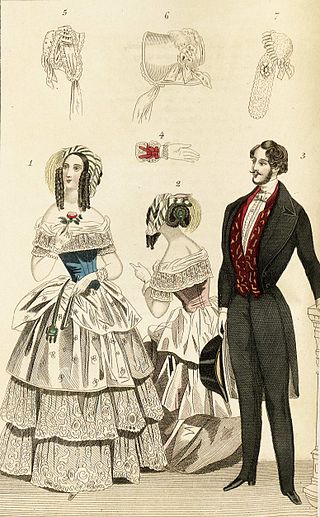
Victorian fashion consists of the various fashions and trends in British culture that emerged and developed in the United Kingdom and the British Empire throughout the Victorian era, roughly from the 1830s through the 1890s. The period saw many changes in fashion, including changes in styles, fashion technology and the methods of distribution. Various movement in architecture, literature, and the decorative and visual arts as well as a changing perception of gender roles also influenced fashion.

Tightlacing is the practice of wearing a tightly laced corset. It is done to achieve cosmetic modifications to the figure and posture or to experience the sensation of bodily restriction.
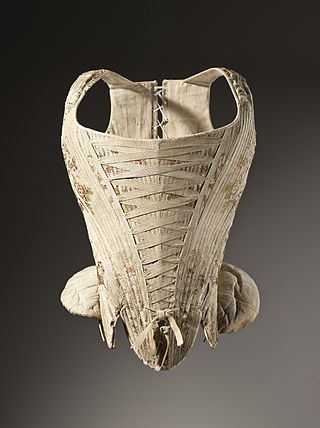
The corset is a supportive undergarment for women, dating, in Europe, back several centuries, evolving as fashion trends have changed and being known, depending on era and geography, as a pair of bodies, stays and corsets. The appearance of the garment represented a change from people wearing clothes to fit their bodies to changing the shape of their bodies to support and fit their fashionable clothing.
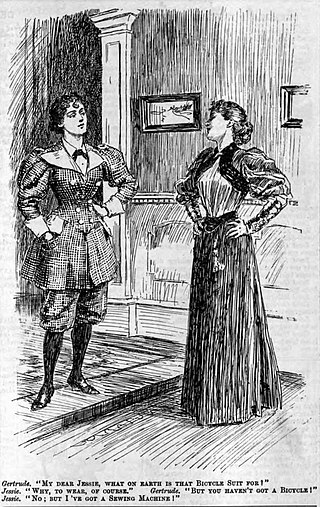
Victorian dress reform was an objective of the Victorian dress reform movement of the middle and late Victorian era, led by various reformers who proposed, designed, and wore clothing considered more practical and comfortable than the fashions of the time.
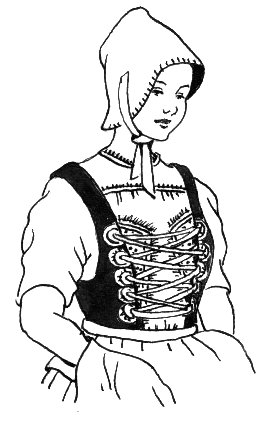
A bodice is an article of clothing traditionally for women and girls, covering the torso from the neck to the waist. The term typically refers to a specific type of upper garment common in Europe during the 16th to the 18th century, or to the upper portion of a modern dress to distinguish it from the skirt and sleeves. The name bodice is etymologically an odd plural spelling of "body" and comes from an older garment called a pair of bodies.

A ball gown, ballgown or gown is a type of evening gown worn to a ball or a formal event. Most versions are cut off the shoulder with a low décolletage, exposed arms, and long bouffant styled skirts. Such gowns are typically worn with an opera-length white gloves, vintage jewelry or couture, and a stole, cape, or cloak in lieu of a coat. Where "state decorations" are to be worn, they are on a bow pinned to the chest, and married women wear a tiara if they have one. Although synthetic fabrics are now sometimes used, the most common fabrics are satin, silk, taffeta and velvet with trimmings of lace, pearls, sequins, embroidery, ruffles, ribbons, rosettes and ruching.
Clothing terminology comprises the names of individual garments and classes of garments, as well as the specialized vocabularies of the trades that have designed, manufactured, marketed and sold clothing over hundreds of years.
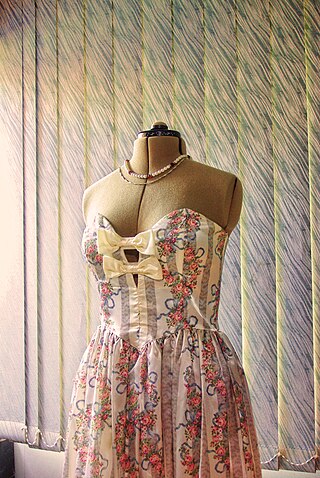
Gunne Sax is a retired clothing label owned by Jessica McClintock, Inc., which specialized in formal and semi-formal wear for young women. Eleanor Bailey and Carol Miller co-founded the label in San Francisco in 1967, before partnering with Jessica McClintock in 1969 for a $5,000 investment.

1850s fashion in Western and Western-influenced clothing is characterized by an increase in the width of women's skirts supported by crinolines or hoops, the mass production of sewing machines, and the beginnings of dress reform. Masculine styles began to originate more in London, while female fashions originated almost exclusively in Paris.

Fashion in the period 1795–1820 in European and European-influenced countries saw the final triumph of undress or informal styles over the brocades, lace, periwigs and powder of the earlier 18th century. In the aftermath of the French Revolution, no one wanted to appear to be a member of the French aristocracy, and people began using clothing more as a form of individual expression of the true self than as a pure indication of social status. As a result, the shifts that occurred in fashion at the turn of the 19th century granted the opportunity to present new public identities that also provided insights into their private selves. Katherine Aaslestad indicates how "fashion, embodying new social values, emerged as a key site of confrontation between tradition and change."
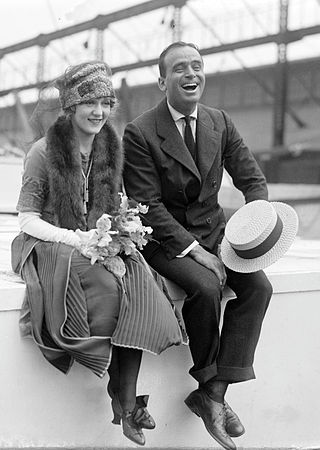
Western fashion in the 1920s underwent a modernization. For women, fashion had continued to change away from the extravagant and restrictive styles of the Victorian and Edwardian periods, and towards looser clothing which revealed more of the arms and legs, that had begun at least a decade prior with the rising of hemlines to the ankle and the movement from the S-bend corset to the columnar silhouette of the 1910s. Men also began to wear less formal daily attire and athletic clothing or 'Sportswear' became a part of mainstream fashion for the first time. The 1920s are characterized by two distinct periods of fashion: in the early part of the decade, change was slower, and there was more reluctance to wear the new, revealing popular styles. From 1925, the public more passionately embraced the styles now typically associated with the Roaring Twenties. These styles continued to characterize fashion until the worldwide depression worsened in 1931.

Fashion in the period 1900–1909 in the Western world continued the severe, long and elegant lines of the late 1890s. Tall, stiff collars characterize the period, as do women's broad hats and full "Gibson Girl" hairstyles. A new, columnar silhouette introduced by the couturiers of Paris late in the decade signaled the approaching abandonment of the corset as an indispensable garment.
This is a list of existing articles related to fashion and clothing. For individual designers, see List of fashion designers

A dress is a garment traditionally worn by women or girls consisting of a skirt with an attached bodice. It consists of a top piece that covers the torso and hangs down over the legs. A dress can be any one-piece garment containing a skirt of any length, and can be formal or casual.

A basque is an item of women's clothing. The term, of French origin, originally referred to types of bodice or jacket with long tails, and in later usage a long corset, characterized by a close, contoured fit and extending past the waistline over the hips. It is so called because the original French fashion for long women's jackets was adopted from Basque traditional dress. In contemporary usage it refers only to a long item of lingerie, in effect a brassiere that continues down, stopping around the waist or the top of the hips, the lower part essentially decorative rather than providing support or indeed warmth.

In fashion, a sheath dress is a fitted, straight cut dress, often nipped at the waistline with no waist seam. When constructing the dress, the bodice and skirt are joined together by combining the skirt darts into one dart: this aligns the skirt darts with the bodice waist dart. The dress emphasizes the waist as its skirt portion is fitted. While the sheath dress can come in many patterns and lengths, it often is worn with short sleeves and reaches knee length.

Kate Lambert, known professionally as "Kato", is a British model, fashion designer, singer and entrepreneur. A native of Wales, Kato emigrated to the United States in 2007. She became a US citizen in 2019.























